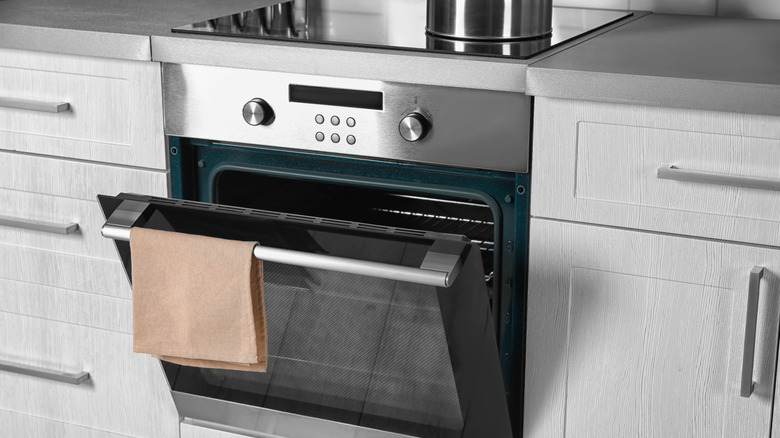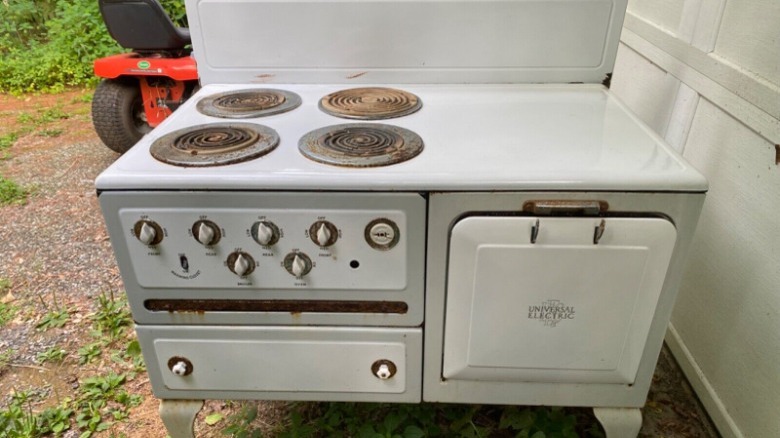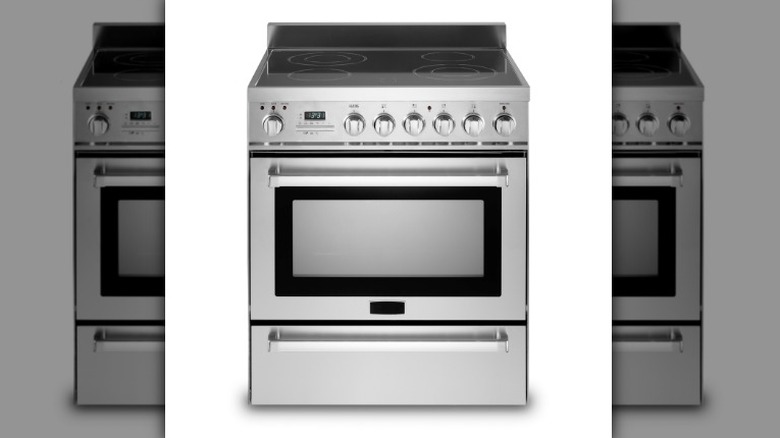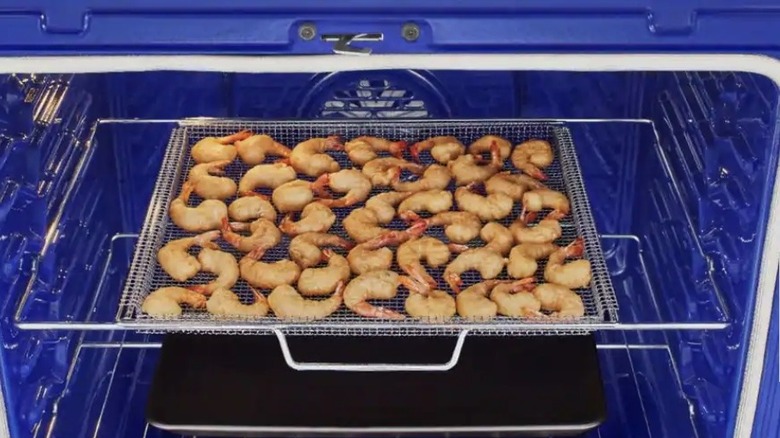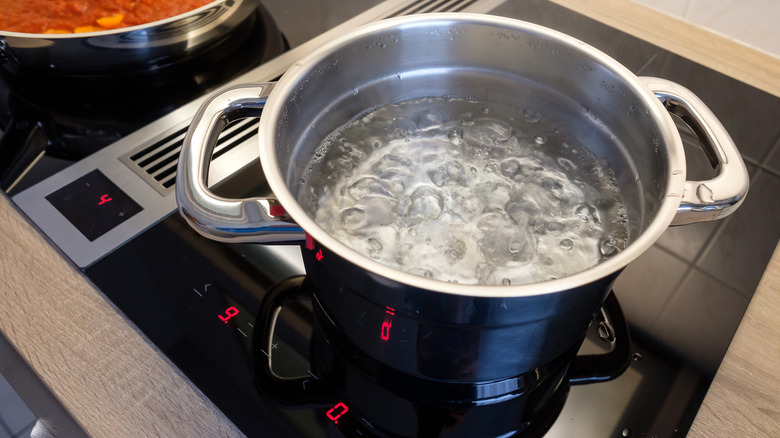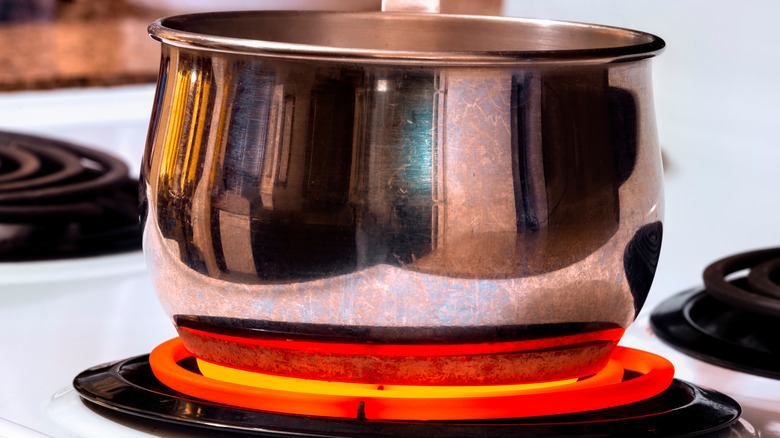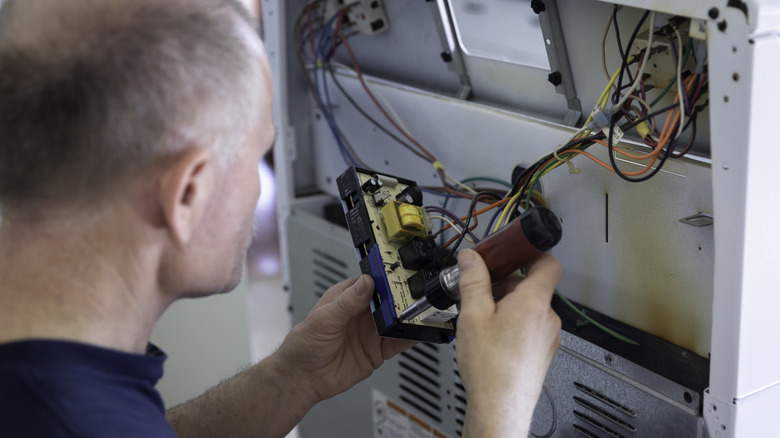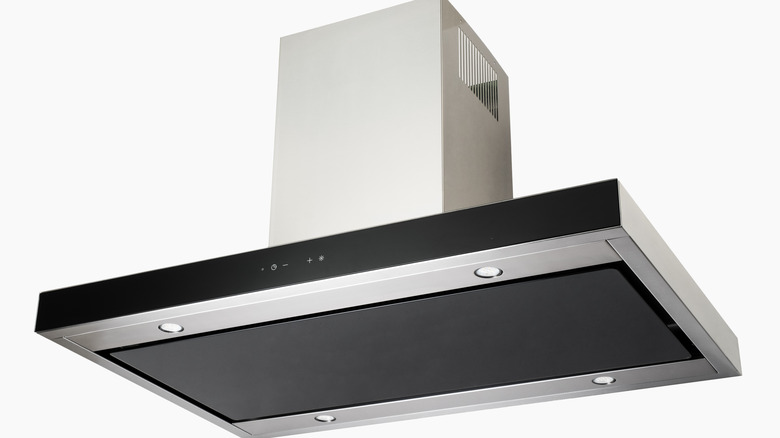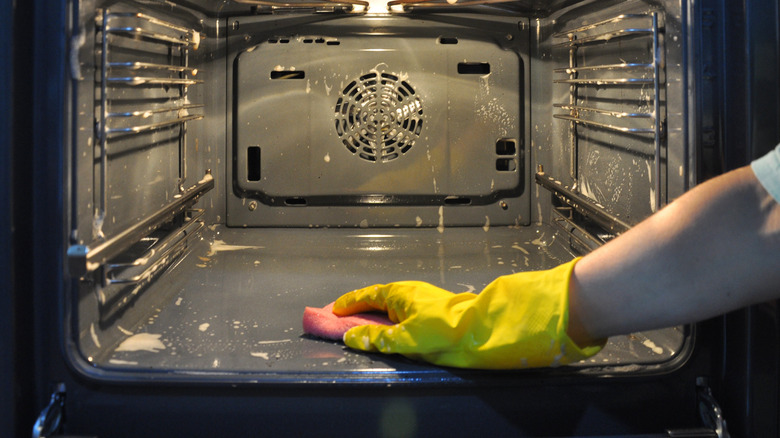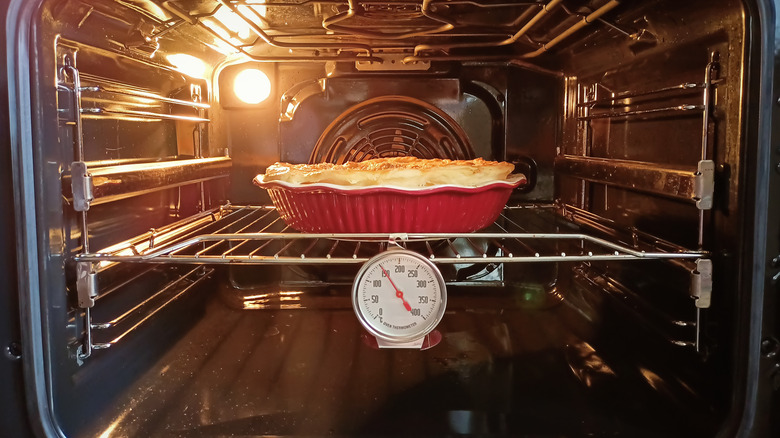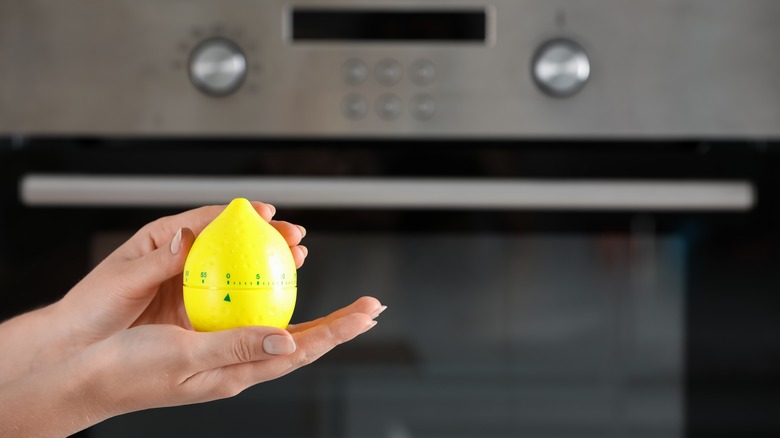11 Facts You Need To Know About Electric Ovens
You'll often hear enthusiastic home cooks insist that gas ovens are the best kind. The reason given is one that actually applies to the stovetop rather than the oven itself, though. As appliance maker Maytag explains, a stovetop+oven combo is more accurately known as a range or stove. Let's set aside such semantic quibbles for now as most home kitchens come equipped with a range (or stove) instead of a separate stove and oven. Therefore, a gas oven will typically have a gas stove attached, and, yes, you can fiddle the knobs on the latter to more precisely control the temperature.
Recently, however, there's been some news coming out that makes gas ranges a lot less desirable. For one thing, it seems that they cause far more air pollution than their electric counterparts, reports PBS. Even if you're not much of an eco-warrior, this should still concern you because the government is considering implementing regulations regarding these appliances. No, this doesn't mean they're going to go door to door confiscating non-compliant appliances, but there's a possibility that if you're in the market for a new stove a few years from now, you may need to get used to the idea of an electric one. If you already have one, well, you now have the right to feel smug after all those years of hearing your foodie friends boast about cooking with gas.
The government may subsidize your purchase of one
One advantage electric ranges typically have over gas ones is that they're less expensive. Avail notes that basic electric ranges are commonly found in lower-end rentals for this reason. On the other hand, the world's priciest stoves ($10,000+) are nearly all gas ones. Electric stoves may not be upmarket, but they just got a huge boost in the affordability department. Thanks to a new government bill, there's a chance your next one could be free! What, the government's actually offering to cover the cost of a major kitchen appliance? Well, under certain circumstances, yes. This is thanks to the Inflation Reduction Act of 2022, aka H.R.5376.
If you don't want to wade through the government jargon, Wirecutter explains that if you make 80% or less of your area's median income, you can buy an electric range costing up to $840 and get a 100% rebate. If you earn between 80% and 150% of the median income, 50% of your purchase cost qualifies for a refund up to $840, meaning you'd get ½ off any stove costing $1,680 or less. Additional funds are also available to help with the cost of any necessary installation, rewiring, et cetera (more on this below). You should be aware that the IRA rebates may not have been rolled out in your state just yet, so it's probably best to hold off on your purchase until you've confirmed that the program is set to go.
They have been around a lot longer than you think
Are you excited at the thought of a free or deeply-discounted electric range? So are we! Before getting into the nitty-gritty of choosing what type and making plans for any necessary installation, though, let's take a nostalgic look back at the early years of our soon-to-be-favorite appliance. While the very first cooking was likely done over an open fire, ThoughtCo. informs us that even by ancient times, people were starting to come up with rudimentary clay ovens. The first gas oven came on the scene in 1826 (earlier ovens used wood, coal, and even kerosene), but was followed some six decades or so later by an electric version.
One early electric range made its debut at the 1893 Chicago World's Fair, the same one that also helped introduce the nation to chili, brownies, and canned sardines (not all together, though, as that would be gross). Apparently, the electric technology still needed some tweaking, though, as these amazing new stoves really didn't start to compete with the old-style gas ones for about 40 years. By the early 1930s, they were starting to catch on — at least in households that could afford such a thing during the Great Depression. Too bad our great-grandparents didn't have any New Deal programs in place to subsidize their stove purchasing, but it makes us all the more grateful for that IRA rebate.
Convection-style ranges are becoming quite common
If you haven't gone shopping for a new range in a while, you may be wondering what's on offer these days. Just for fun, we checked out the selection offered by Wayfair. Currently, Wayfair is offering a total of 126 electric ranges, 61% (77) of which are of the convection type. Convection cooking involves having the air circulated by a fan. While it heats food more quickly and efficiently, it does mean that baking recipes may need to be adjusted to account for this, typically by dropping the temperature by 25 degrees and reducing the cooking time by 25%.
According to The Washington Post, most home convection ranges have fans that can be switched on for convection cooking or switched off for recipes where air circulation isn't desirable. The dedicated convection cooker, however, may prefer a more expensive "true convection" model with an additional heating element adjacent to the fan. One thing we like about the lower-end ones is that they're not too pricy, with Wayfair offering one that costs only about $200 more than the cheapest conventional range. Having this option for a not-so-significant upcharge, particularly if you can turn it on and off as needed, means you may want to consider a convection oven for your next purchase. After all, Wayfair offers one model under $840 and several that don't cost much more.
Many new ones have built-in air fryers
Let's take a little break from perusing Wayfair's offerings and see what's for sale at Home Depot, shall we? At present, it looks like it's offering 179 different electric ovens of all different types. Thirty-four of these ovens, however, have a pretty cool add-on: They also serve as air fryers. How do manufacturers manage to get air fryers into ovens? It's quite simple, really, as long as the oven is a convection one. Both types of appliance work by circulating hot air with a fan, so in a sense, all food that is convection baked is actually "air fried."
Air-fry ovens, as opposed to straight-up convection ones, may also include some type of rack or basket, although there's a possibility this will need to be purchased separately. Spencer's TV & Appliance also informs us that on the air fry setting the fan may circulate the air more quickly than it would in standard convection mode. One advantage to using the air fry program when appropriate is that it may not be necessary to preheat the oven. It also means you can clear one more small appliance off the countertop, which is always a plus. What's more, you can finally cook that "fried" Thanksgiving turkey you've always wanted without running the risk of burning down your house.
Induction ranges may be the best kind (if you can afford one)
If you've got the money — perhaps you only qualify for the 50% rebate, but want to max out your $840 benefit by purchasing a $1,680 stove — consider an induction range. This type of electric range isn't as common and is significantly more expensive than a conventional model. Going back to Wayfair, this site offers 20 induction ranges with prices ranging from just below $1,200 to upwards of $9,000. (At the time of writing, it also shows one model priced under $1,000, but a close look at the description and reviews reveal this to be a miscategorized conventional model with no induction feature.)
Despite the expense, Consumer Reports lists a number of reasons to purchase an induction range. For one thing, the cooktop is far more efficient and will boil water or heat up a pan in less than half the time of other methods. For another, induction ranges are quite safe since if there is no pot on the burner, it won't heat up. The reason for this is that induction heat works by generating an electromagnetic field, thus requiring a magnetic pot in order to work. The downside, of course, is that not all types of cookware are induction-compatible. Stainless steel and cast iron usually work just fine; aluminum, not so much. Even with this potential downside, Wirecutter raves about induction and feels it may be the wave of the future once it catches on.
They still make coil-top ranges
If you've lived in older homes or rented not-too-fancy apartments, there's a chance that the electric ranges you're familiar with are of the old-fashioned coil-top design. In recent years, however, it seems as if smooth-top ranges with sleek ceramic glass surfaces have completely taken over the market. This isn't entirely true, however. Even our old friend Wayfair offers 30 different coil top models, most (although not all) on the more budget-friendly end of the spectrum.
Assuming you want to max out that $840 IRA benefit, why would you wish to purchase a coil top electric range? Are there any advantages, apart from generally being cheaper than smooth-top ones? Bellingham Electric says yes, starting with the fact that glass stovetops can break. They're not likely to do so if handled with care, but if you're accident-prone and do something like dropping a frozen chicken or cast-iron pan on the cooktop, it's not inconceivable that the glass could shatter and make for an expensive (and non-government-subsidized) repair. Glass cooktops can also become cloudy, pitted, or scratched if you don't clean them well and often, although they're usually easier to clean. One more plus in the coil top column is that coils heat up more quickly than glass surfaces, although a minus is that they also take longer to cool down. Still, there's a solution for this: burner covers. You can buy a two-pack at Dollar Tree for a buck and a quarter.
You may need re-wiring if you're switching from a gas range to an electric one
One problem with switching from a gas range to an electric one is that it's probably not going to be as easy as simply purchasing a new appliance and arranging to have the old one hauled away. As Service One explains, gas ranges typically operate on a 110-volt circuit, while most electric stoves take 220 volts plus a different type of wiring capable of bearing a heavier electrical load. You'll probably also need to have the gas pipe that fueled your former stove capped and have the valve shut off, as well.
As you probably guessed, all this is going to cost you. Home Advisor notes that even if you're just swapping a freestanding gas oven for an electric one of similar dimensions, the wiring may run upwards of $300, while a circuit breaker could tack on an additional $65 to $200. The good news, however, is that Rewiring America comes bearing tidings of great joy: The good old Inflation Reduction Act allocates up to $2,500 towards the cost of rewiring in addition to the $840 that goes towards the stove purchase.
A range hood can help keep the kitchen clean
There's one more upcharge mentioned by Home Advisor that the IRA most likely will not cover; that being a vent hood. This may cost up to $600 for the purchase and installation. Is a hood something you need, and, if not, why would you want to fork over the big bucks for such an option? Cafe Toscana dives into the topic of whether electric ranges in the home should be vented. Spoiler alert: It says yes, but you can make up your own mind when you read the reasons given.
For starters, it's good to know that a range hood with a fan and filter should do the trick with an electric oven, so there's no need to drill through the wall and vent to the outside if you'd rather not go to that extent. The main reason for venting your electric stove is that if it lets off any smoke, perhaps because there's some burnt-on food, the smoke may escape from the oven and will dirty up your walls, as well as do bad things to the indoor air quality. If the smoke stays inside the oven, it won't do much to improve your food. What can you do, though, if you can't afford or don't have room for a range hood? In such a case, you can simply clean the oven instead.
The self-cleaning feature may not be such a blessing
When it's time to clean the oven, which will be as soon as you spill something, smell something odd, and/or smoke starts pouring out, it's best to do so ASAP. What's the best method, though? That's a trickier question. One option is to use your oven's self-cleaning feature since it very likely has this setting. Good Housekeeping tells us that the first self-cleaning oven dates back to 1963, and by now, this feature is common to even the cheapest ovens. Self-cleaning works by cranking the oven up to scary-high temperatures as high as 900 F. The cleaning cycle takes about three hours, maybe more, during which time the oven stays locked shut, but it still gets pretty hot on the outside.
The thing that makes self-cleaning so problematic, according to Tech Advisor, is that super-high heat can, over time, damage your oven. It also makes carbon monoxide, plus there's a risk of a fire starting inside the oven. On the upside, at least you're not using horrible caustic chemicals such as the kind found in many spray-on oven cleaners. Still, though, are there any non-terrifying ways to clean your oven? Family Handyman suggests a good hard scrub with a baking soda/water paste. Sure, cleaning your oven the non-toxic way will require plenty of elbow grease, but just think of it as a workout for your arms as well as a chance to spare your lungs.
Electric ranges cook just as well as gas ones (maybe even better)
At long last, we'll get to what may be the heart of the matter for any gas stove owners not completely won over by the thought of that $840 subsidy: What about the so-called fact that gas simply cooks better than electric ovens? Well, apart from that whole air pollution thing, the myth of gas stove superiority may be just that — a pretty piece of fiction designed to justify the higher prices. As Wirecutter relates, gas ranges are far less efficient, transferring just 32% of the heat generated to the food being cooked as opposed to 75% from standard electric ovens and 82% from induction cooktops.
Electric ovens also have it all over their gas counterparts, as per Do It Yourself, in that the heat they produce tends to be more evenly distributed. What's more, it's a drier heat, so your chicken skin will come out nice and crispy and your pastries less soggy. Should you happen to want moist heat, though, you can put a cup (a heatproof one, of course) filled with water into your electric oven as you're baking.
Electric ranges do have their drawbacks
Electric ranges have their downsides, as well.
As Do It Yourself points out, the day-to-day operating costs of a gas range tend to be cheaper than those of an electric one in the same way that heating your home with gas is generally cheaper than electric. (All this is subject to change, however, as energy prices are constantly in flux.) Gas stoves can also be operated even when the power goes out, while you do need electricity to light your electric oven. It's even easier in an emergency to light a candle from a gas burner than an electric one, although using a disposable lighter is an easier (and safer) option. One last point in favor of gas stoves is that they both heat up and cool down more rapidly... or do they? In recent tests, Consumer Reports found certain electric stoves to have the edge here, so heat speed may vary more from model to model than it does based on fuel source alone.
